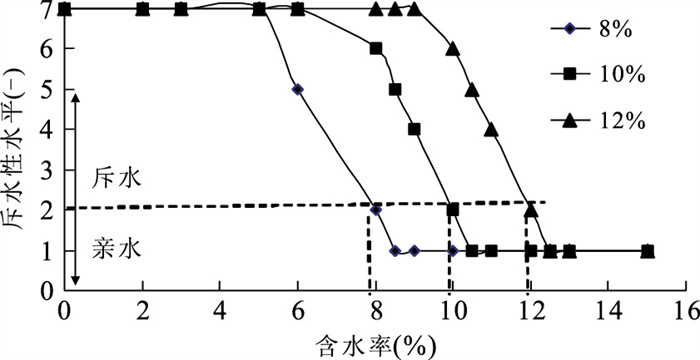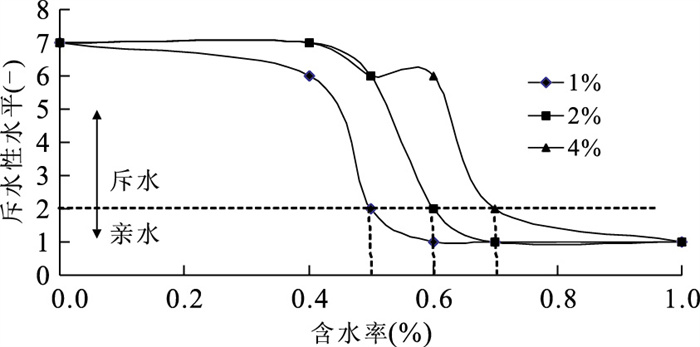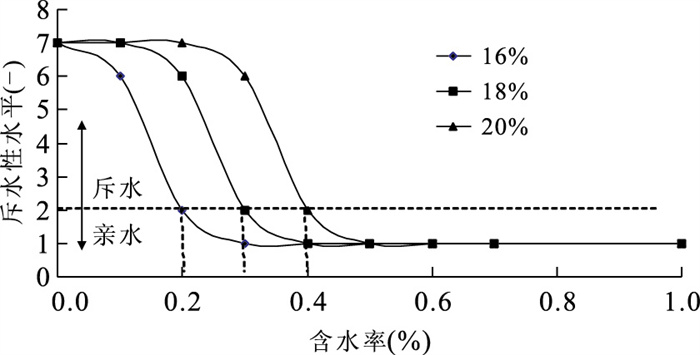Characteristics of Wettability Variation of Oil-Contaminated Porous Medium
-
摘要: 一定程度的石油污染可使多孔介质的湿润性发生变异,导致介质持水能力降低、地下水石油污染、粮食产量品质下降等.采用滴水穿透时间法与酒精溶液入渗法,测定了亚粘土和粗砂在不同柴油、机油含量下的斥水水平,确定了亚粘土、粗砂由亲水表面变为疏水表面的临界含油量.结果表明,亚粘土、粗砂湿润性变异的临界机油含量分别约为7%、0.5%,粗砂湿润性变异的临界柴油含量约为14%,而柴油污染对亚粘土湿润性的影响不显著.另外,当石油污染多孔介质的含水量达到某一临界值时,湿润性将再次发生反转,由疏水表面变回亲水表面.测得机油、柴油污染粗砂的临界含水量约在0.2%~1%之间,机油污染亚粘土的临界含水量在数值上与其含油量近似相等.Abstract: A certain degree of oil pollution can lead to wettability variation in porous medium, which can bring about low water-holding capacity, oil contamination of groundwater, low food quality and production. In this study, water repellency of sand and clay was measured by WDPT and MED methods under different diesel and engine oil contents. Critical oil content of porous media in oil-contaminated porous media was determined preliminarily, beyond which hydrophilic surface could change into hydrophobic surface. The results show that critical oil contents of clay and sand contaminated by engine oil are about 7% and 0.5% respectively. Critical oil content of sand contaminated by diesel is about 14%, while diesel doesn't have remarkable effect on water repellency. In addition, when water content increases to a critical value, wettability of oil-contaminated porous medium will reverse again. Critical water contents of sand contaminated by engine oil and diesel are both between 0.2%-1%, while critical water content of clay contaminated by engine oil is approximately equal to its oil content in value.
-
表 1 供试多孔介质的粒径分布与物理性质
Table 1. Grain size distribution and physical properties for porous media samples
多孔介质 比重 比表面积(m2·g-1) 各粒组含量(%) 工程分类 2~1 (mm) 1~0.5 (mm) 0.5~0.25 (mm) 0.25~0.1 (mm) 0.1~0.075 (mm) 0.075~0.005 (mm) 砂性土 2.66 4.69 17.4 45.3 27.9 8.1 0.3 1.0 粗砂 粘性土 2.70 31.57 0.6 0.3 0.2 0.7 75.6 22.6 粉质亚粘土 表 2 供试油品的基本性质
Table 2. Basic properties of diesel and engine oil
油品名称 密度(g·cm-3) 粘滞系数(mPa·s) 表面张力(mN·m-1) 油-水界面张力(mN·m-1) 0#柴油 0.848 3.56~4.05 27.8 19.0 CD15W-40机油 0.878 404~444 31.2 24.5 表 3 酒精溶液入渗法的斥水性描述与水平标准
Table 3. Water repellency description and level standard of MED method
水平 斥水性描述 酒精溶液体积分数(%) 7 极端斥水 36 6 异常强烈斥水 24 5 强烈斥水 13 4 中度斥水 8.5 3 轻微斥水 5 2 亲水 3 1 异常亲水 0 表 4 不同机油含量下亚粘土的MED入渗时间
Table 4. Infiltration time in clay by MED method in the condition of different engine oil contents
多孔介质含油率 不同体积分数的酒精溶液的入渗时间(s) 0 3% 5% 8.5% 13% 24% 36% 4% 1.82 1.63 1.31 1.12 0.95 0.66 0.52 6% 2.75 2.52 2.35 2.05 1.82 1.45 1.15 7% 4.51 4.34 4.03 3.65 3.12 2.41 2.14 7.25% 6.32 6.46 6.33 6.16 5.05 4.44 2.33 7.5% 6.54 6.74 7.45 6.82 6.75 4.81 2.43 8% 7.87 8.63 8.12 7.51 7.24 5.73 2.72 10% 34.21 27.61 25.23 17.52 17.53 11.23 3.44 表 5 不同机油含量下粗砂的MED入渗时间
Table 5. Infiltration time in sand by MED method in the condition of different engine oil contents
多孔介质含油率 不同体积分数的酒精溶液的入渗时间(s) 0 3% 5% 8.5% 13% 24% 36% 0.5% 4.11 3.92 3.65 3.15 2.51 1.82 1.45 0.8% 13.54 13.13 12.82 12.52 11.11 4.33 4.33 1% 30.55 30.23 28.15 23.13 20.92 4.92 1.62 2% 40.13 37.22 33.92 30.62 24.11 5.12 1.81 4% 50.14 42.65 31.32 30.12 26.34 5.74 2.14 表 6 不同柴油含量下粗砂的MED入渗时间
Table 6. Infiltration time in sand by MED method in the condition of different diesel oil contents
多孔介质含油率 不同体积分数的酒精溶液的入渗时间(s) 0 3% 5% 8.5% 13% 24% 36% 14% 4.82 4.64 4.13 3.82 3.15 2.67 2.15 16% 9.15 8.22 7.12 5.26 4.71 3.21 1.92 18% 14.15 13.81 13.34 12.91 5.34 4.33 2.18 -
Chen, J.Y., Zhang, Z.T., Gillerman, L., et al., 2009. Effect of different contamination domestic waste water on soil water repellency. Water Saving Irrigation, 10: 13-16, 19 (in Chinese with English abstract). http://en.cnki.com.cn/Article_en/CJFDTOTAL-JSGU200910005.htm Doerr, S.H., Shakesby, R.A., Walsh, R.P.D., 2000. Soil water repellency: its causes, characteristics and hydro-geomorphological significance. Earth-Science Revviews, 51(1-4): 33-65. doi: 10.1016/S0012-8252(00)00011-8 Jarvis, N., Etana, A., Stagnitti, F., 2008. Water repellency, near-saturated infiltration and preferential solute transport in a macroporous clay soil. Geoderma, 143(3-4): 223-230. doi: 10.1016/j.geoderma.2007.11.015 Jiang, P., Zhang, G.C., Ge, J.J., et al., 2007. Progress in the research of wettability reversal mechanism. Journal of Xi'an Shiyou University (Natural Science Edition), 22(6): 78-84 (in Chinese with English abstract). http://en.cnki.com.cn/Article_en/CJFDTOTAL-XASY200706019.htm Letey, J., Carrillo, M.L.K., Pang, X.P., 2000. Approaches to characterize the degree of water repellency. Journal of Hydrology, 231-232: 61-65. doi: 10.1016/S0022-1694(00)00183-9 McKissock, I., Walker, E.L., Gilkes, R.J., et al., 2000. The influence of clay type on reduction of water repellency by applied clays: a review of some West Australian work. Journal of Hydrology, 231-232: 323-332. doi: 10.1016/S0022-1694(00)00204-3 Nieber, J.L., Bauters, T.W.J., Steenhuis, T.S., et al., 2000. Numerical simulation of experimental gravity-driven unstable flow in water repellent sand. Journal of Hydrology, 231-232: 295-307. doi: 10.1016/S0022-1694(00)00202-X Quyum, A., Achari, G., Goodman, R.H., 2002. Effect of wetting and drying and dilution on moisture migration through oil contaminated hydrophobic soils. The Science of the Total Environment, 296(1-3): 77-87. doi: 10.1016/S0048-9697(02)00046-3 Simkovic, I., Dlapa, P., Doerr, S.H., et al., 2008. Thermal destruction of soil water repellency and associated changes to soil organic matter as observed by FTIR spectroscopy. Catena, 74(3): 205-211. doi: 10.1016/j.catena.2008.03.003 Sonneveld, M.P.W., Backx, M.A.H.M., Bouma, J., 2003. Simulation of soil water regimes including pedotransfer functions and land-use related preferential flow. Geoderma, 112(1-2): 97-110. doi: 10.1016/S0016-7061(02)00298-7 Stefan, H.D., 1998. On standardizing the 'water drop penetration time' and the 'molarity of an ethanol droplet' techniques to classify soil hydrophobicity: a case study using medium textured soils. Earth Surf. Process and Landforms, 23(7): 663-668. doi: 10.1002/(SICI)1096-9837(199807) Tessler, N., Wittenberg, L., Malkinson, D., et al, 2008. Fire effects and short-term changes in soil water repellency-Mt. Carmel, Israel. Catena, 74(3): 185-191. doi: 10.1016/j.catena.2008.03.002 Thwaites, L.A., de Rooij, G.H., Salzman, S., et al., 2006. Near-surface distributions of soil water and water repellency under three effluent irrigation schemes in a blue gum (Eucalyptus globules) plantation. Agricultural Water Management, 86(1-2): 212-219. doi: 10.1016/j.agwat.2006.07.002 Travis, M.J., Welsbrod, N., Gross, A., 2008. Accumulation of oil and grease in soils irrigated with grey water and their potential role in soil water repellency. Sci. Total Environ. , 394(1): 68-74. doi: 10.1016/j.scitotenv.2008.01.004 van Dam, J.C., Hendrickx, J.M.H., Van Ommen, H.C., et al., 1990. Water and solute movement in a coarse-textured water-repellent field soil. Journal of Hydrology, 120(1-4): 359-379. doi: 10.1016/0022-1694(90)90159-U Wu, Y.L., Li, Z.Z., Gong, Y.S., 2007. Correlation of soil water repellency measurements from two typical methods. Transactions of the CSAE, 23(7): 8-13 (in Chinese with English abstract). http://dl.sciencesocieties.org/publications/tcsae/abstracts/2007/7/2007.7.002 Yang, B.J., Blackwell, P.S., Nicholson, D.F., 1996. Modeling heat and water movement in a water-repellent sandy soil. Acta Pedologica Sinica, 33(4): 351-359 (in Chinese with English abstract). http://www.cnki.com.cn/Article/CJFDTotal-TRXB604.003.htm Zheng, X.L., Qiu, H.X., Jing, J., et al., 2000. Numerical modeling on elimination of oil-polluted soils in Shenyang-Fushun irrigation area. Earth Science—Journal of China University of Geosciences, 25(5): 462-466 (in Chinese with English abstract). http://en.cnki.com.cn/Article_en/CJFDTOTAL-DQKX200005003.htm Zheng, X.L., Wang, B.C., She, Z.L., et al., 2004. Theory and application research on oil contaminated soil-groundwater System. Geology Press, Beijing (in Chinese). 陈俊英, 张智韬, Gillerman, L., 等, 2009. 不同污染程度的水对土壤斥水性的影响. 节水灌溉, 10: 13-16, 19. https://www.cnki.com.cn/Article/CJFDTOTAL-JSGU200910005.htm 蒋平, 张贵才, 葛际江, 等, 2007. 润湿反转机理的研究进展. 西安石油大学学报(自然科学版), 22(6): 78-84. doi: 10.3969/j.issn.1673-064X.2007.06.019 吴延磊, 李子忠, 龚元石, 2007. 两种常用方法测定土壤斥水性结果的相关性研究. 农业工程学报, 23(7): 8-13. doi: 10.3321/j.issn:1002-6819.2007.07.002 杨邦杰, Blackwell, P.S., Nicholson, D.F., 1996. 斥水性土壤中的水热运动规律与数值模型. 土壤学报, 33(4): 351-359. 郑西来, 邱汉学, 荆静, 等, 2000. 沈抚灌区石油污染土壤恢复方案的数值模拟. 地球科学——中国地质大学学报, 25(5): 462-466. https://www.cnki.com.cn/Article/CJFDTOTAL-DQKX200005003.htm 郑西来, 王秉忱, 佘宗莲, 2004. 土壤-地下水系统石油污染原理与应用研究. 北京: 地质出版社. -










 下载:
下载:




